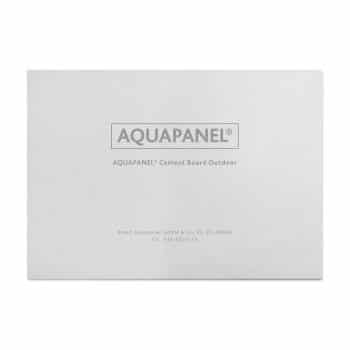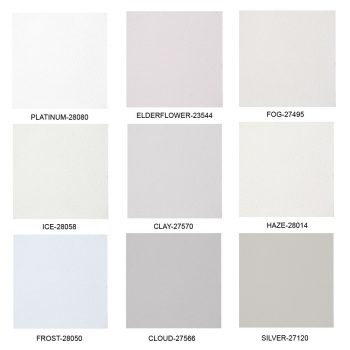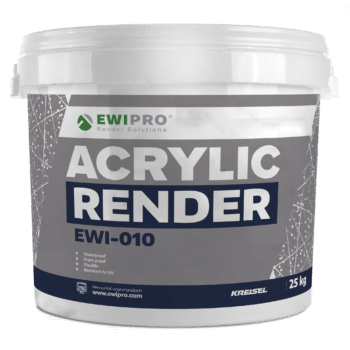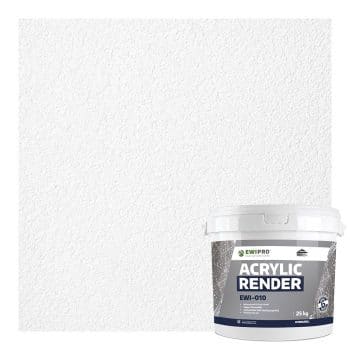What Do I Need to Render My Knauf Aquapanel?
The Knauf Aquapanel is an outdoor cement board, designed for the building and decorating of exterior facades. These render carrier boards are particularly strong and are ideal for withstanding even the most extreme weather conditions. If you’re planning on installing a render system onto the Knauf Aquapanel, then keep reading!
Today’s blog post is an installation and rendering guide for the Knauf Aquapanel, which is now a BBA Approved system. The certificate is available to access here. We’re going to be talking about how to install the boards and then how to apply the EWI Pro thin coat render system onto them.
-
Knauf AQUAPANEL® Cement Board Outdoor – 12.5mm (2.4m x 0.9m)
£71.99 Incl. VAT£59.99 Excl. VAT
Installing the Knauf Aquapanel Boards
To start off, Knauf Aquapanel is screwed onto vertical timber battens using 42-60mm self-drilling screws. Use approximately 23 screws per board, and a 3mm gap needs to be left in between each board.
-
Premium Basecoat (EWI-225) – 25kg
Rated 5.00 out of 5£20.90 Incl. VAT£17.42 Excl. VAT£23.23 Incl. VAT£19.36 Excl. VAT
Applying Render
Now that the Knauf Aquapanel boards are prepared and ready to go, you can go straight into applying the thin coat render system.
First, the EWI-225 Premium Basecoat needs to be mixed with 6 litres of clean, cool water using an electric paddle mix until it is a smooth, workable consistency. This is our strongest basecoat-adhesive. Therefore, it is ideal for applications onto render carrier boards as it will help to resist cracking.
Apply the basecoat to a thickness of 6mm. At this stage, you should embed the Fibreglass Mesh into the basecoat. The embedding of the mesh serves to enhance the tensile strength of the system. The overlapping of the mesh is crucial, and must be to a width of 10cm.
Remember that you are applying a thin coat render, and therefore the basecoat needs to be perfectly smooth and flat. This will ensure that any imperfections are not visible through the final render finish. We have compiled a buyer’s guide detailing the same installation process here.
Once set, the basecoat will need priming with a render primer. Although optional, we do recommend the use of a render primer if you have chosen an especially bright colour for the topcoat, as the primer can be tinted to match the render and will ensure an even coloured finish.
The final stage in the render system is the topcoat. Whether you’ve chosen the EWI-010 Acrylic Render or EWI-076 Premium Bio Silicone Render, the application is always the same. The application of the render needs to correspond with your chosen grain size. Therefore, a 1.5mm textured finish requires 1.5mm render application. Once the render itself is on the wall, it needs rubbing up using a plastic render float.
-
Premium Bio Silicone Render (EWI-076) – 25kg
Rated 4.00 out of 5From £113.39 Incl. VATFrom £94.49 Excl. VAT -
Acrylic Render (EWI-010) – 25kg
Rated 4.50 out of 5From £47.99 Incl. VATFrom £39.99 Excl. VAT
The BBA System
The viability of the new BBA approved system stems from the adherence to four distinct factors. Firstly, the strength and stability of the silicone render ensures that the systems adequately resists wind loads, and can withstand any impact resistance that may be encountered in regular service. As it is an external wall system, the fire resistance is of high importance. The Silicone Render system achieved the A2-s1 d0 fire classification, ranking it as non-combustible in Scotland, and of limited combustibility in England and Wales. The weather resistance of the silicone render has also been ratified, as they shed water under observation. Therefore, the system significantly reduces the amount of water penetrating the substrate. Additionally, the BBA ascertains that the durability of the system results in a service life in excess of 30 years.
System components
The Knauf board used is the subject of BBA Certificate 09/4633, and partnered with our materials, forms the new system. The EWI Pro materials used in the system are as follows:
- EWI-225 Premium Basecoat — white Portland cement, mineral fillers, synthetic fibres, polymers and modifying admixtures
- EWI-66645 Fibreglass Mesh — a 1 m wide, woven glass fibre reinforcing mesh with polymer coating, nominal weight of 160 g.m-2
- EWI-333 Topcoat Primer — a water-based primer, containing silicone resin, quartz aggregate, pigments and enhancers
- EWI-076 Premium Bio Silicone Render — a water dispersion of silicone polymer, mineral fillers, refining agents and pigments. Available in 1.0, 1.5, 2.0 and 3.0 mm grain sizes
- EWI-075 Silicone Render — silicone emulsions, nano-particle silicone polymer dispersion, fillers, modifying admixtures and pigments. Available in 1.0, 1.5, 2.0 and 3.0 mm grain sizes
The inclusion of both EWI-075 and EWI-076 in the certificate is a particular rewarding accreditation as they are truly our premier products. They have unrivalled flexibility and crack resistance, whilst also holding excellent hydrophobic qualities. EWI-076 is also resistant to algae and biological growth, as well as being self cleaning.
If you have any other questions about rendering your Knauf Aquapanel, get in touch with our sales team!
Facebook
Twitter
LinkedIn
Your cart
Trade Account Login

We use cookies on our website to give you the most relevant experience by remembering your preferences and repeat visits. By clicking “Accept All”, you consent to the use of ALL the cookies. However, you may visit "Cookie Settings" to provide personalised consent.
Manage consent
Privacy Overview
This website uses cookies to improve your experience while you navigate through the website. Out of these, the cookies that are categorized as necessary are stored on your browser as they are essential for the working of basic functionalities of the website. We also use third-party cookies that help us analyze and understand how you use this website. These cookies will be stored in your browser only with your consent. You also have the option to opt-out of these cookies. But opting out of some of these cookies may affect your browsing experience.
Necessary cookies are absolutely essential for the website to function properly. These cookies ensure basic functionalities and security features of the website, anonymously.
| Cookie | Duration | Description |
|---|---|---|
| __stripe_mid | 1 year | This cookie is set by Stripe payment gateway. This cookie is used to enable payment on the website without storing any patment information on a server. |
| __stripe_sid | 30 minutes | This cookie is set by Stripe payment gateway. This cookie is used to enable payment on the website without storing any patment information on a server. |
| _GRECAPTCHA | 5 months 27 days | This cookie is set by the Google recaptcha service to identify bots to protect the website against malicious spam attacks. |
| apbct_cookies_test | session | CleanTalk sets this cookie to prevent spam on comments and forms and act as a complete anti-spam solution and firewall for the site. |
| apbct_page_hits | session | CleanTalk sets this cookie to prevent spam on comments and forms and act as a complete anti-spam solution and firewall for the site. |
| apbct_prev_referer | session | Functional cookie placed by CleanTalk Spam Protect to store referring IDs and prevent unauthorized spam from being sent from the website. |
| apbct_site_landing_ts | session | CleanTalk sets this cookie to prevent spam on comments and forms and act as a complete anti-spam solution and firewall for the site. |
| apbct_site_referer | 3 days | This cookie is placed by CleanTalk Spam Protect to prevent spam and to store the referrer page address which led the user to the website. |
| apbct_timestamp | session | CleanTalk sets this cookie to prevent spam on comments and forms and act as a complete anti-spam solution and firewall for the site. |
| apbct_urls | 3 days | This cookie is placed by CleanTalk Spam Protect to prevent spam and to store the addresses (urls) visited on the website. |
| AWSALBCORS | 7 days | This cookie is managed by Amazon Web Services and is used for load balancing. |
| cookielawinfo-checkbox-advertisement | 1 year | Set by the GDPR Cookie Consent plugin, this cookie is used to record the user consent for the cookies in the "Advertisement" category . |
| cookielawinfo-checkbox-analytics | 11 months | This cookie is set by GDPR Cookie Consent plugin. The cookie is used to store the user consent for the cookies in the category "Analytics". |
| cookielawinfo-checkbox-functional | 11 months | The cookie is set by GDPR cookie consent to record the user consent for the cookies in the category "Functional". |
| cookielawinfo-checkbox-necessary | 11 months | This cookie is set by GDPR Cookie Consent plugin. The cookies is used to store the user consent for the cookies in the category "Necessary". |
| cookielawinfo-checkbox-others | 11 months | This cookie is set by GDPR Cookie Consent plugin. The cookie is used to store the user consent for the cookies in the category "Other. |
| cookielawinfo-checkbox-performance | 11 months | This cookie is set by GDPR Cookie Consent plugin. The cookie is used to store the user consent for the cookies in the category "Performance". |
| ct_checkjs | session | CleanTalk–Used to prevent spam on our comments and forms and acts as a complete anti-spam solution and firewall for this site. |
| ct_fkp_timestamp | session | CleanTalk sets this cookie to prevent spam on the site's comments/forms, and to act as a complete anti-spam solution and firewall for the site. |
| ct_pointer_data | session | CleanTalk sets this cookie to prevent spam on the site's comments/forms, and to act as a complete anti-spam solution and firewall for the site. |
| ct_ps_timestamp | session | CleanTalk sets this cookie to prevent spam on the site's comments/forms, and to act as a complete anti-spam solution and firewall for the site. |
| ct_sfw_pass_key | 1 month | CleanTalk sets this cookie to prevent spam on comments and forms and act as a complete anti-spam solution and firewall for the site. |
| ct_timezone | session | CleanTalk–Used to prevent spam on our comments and forms and acts as a complete anti-spam solution and firewall for this site. |
| elementor | never | This cookie is used by the website's WordPress theme. It allows the website owner to implement or change the website's content in real-time. |
| viewed_cookie_policy | 11 months | The cookie is set by the GDPR Cookie Consent plugin and is used to store whether or not user has consented to the use of cookies. It does not store any personal data. |
Functional cookies help to perform certain functionalities like sharing the content of the website on social media platforms, collect feedbacks, and other third-party features.
| Cookie | Duration | Description |
|---|---|---|
| __zlcmid | 1 year | This cookie is used by Zendesk live chat and is used to store the live chat ID. |
| bcookie | 2 years | LinkedIn sets this cookie from LinkedIn share buttons and ad tags to recognize browser ID. |
| bscookie | 2 years | LinkedIn sets this cookie to store performed actions on the website. |
| lang | session | LinkedIn sets this cookie to remember a user's language setting. |
| lidc | 1 day | LinkedIn sets the lidc cookie to facilitate data center selection. |
| UserMatchHistory | 1 month | LinkedIn sets this cookie for LinkedIn Ads ID syncing. |
Performance cookies are used to understand and analyze the key performance indexes of the website which helps in delivering a better user experience for the visitors.
| Cookie | Duration | Description |
|---|---|---|
| __utma | 2 years | This cookie is set by Google Analytics and is used to distinguish users and sessions. The cookie is created when the JavaScript library executes and there are no existing __utma cookies. The cookie is updated every time data is sent to Google Analytics. |
| __utmb | 30 minutes | Google Analytics sets this cookie, to determine new sessions/visits. __utmb cookie is created when the JavaScript library executes and there are no existing __utma cookies. It is updated every time data is sent to Google Analytics. |
| __utmc | session | The cookie is set by Google Analytics and is deleted when the user closes the browser. It is used to enable interoperability with urchin.js, which is an older version of Google Analytics and is used in conjunction with the __utmb cookie to determine new sessions/visits. |
| __utmt | 10 minutes | Google Analytics sets this cookie to inhibit request rate. |
| __utmv | 2 years | The __utmv cookie is set on the user's device, to enable Google Analytics to classify the visitor. |
| __utmz | 6 months | Google Analytics sets this cookie to store the traffic source or campaign by which the visitor reached the site. |
| sib_cuid | 6 months | Purechat uses this cookie to send data to purechat.com, to connect visitors to the reservation team and track visitors to stay on portal. |
| SRM_B | 1 year 24 days | Used by Microsoft Advertising as a unique ID for visitors. |
Analytical cookies are used to understand how visitors interact with the website. These cookies help provide information on metrics the number of visitors, bounce rate, traffic source, etc.
| Cookie | Duration | Description |
|---|---|---|
| _ga | 2 years | The _ga cookie, installed by Google Analytics, calculates visitor, session and campaign data and also keeps track of site usage for the site's analytics report. The cookie stores information anonymously and assigns a randomly generated number to recognize unique visitors. |
| _gat_gtag_UA_61069204_2 | 1 minute | Set by Google to distinguish users. |
| _gat_UA-61069204-2 | 1 minute | A variation of the _gat cookie set by Google Analytics and Google Tag Manager to allow website owners to track visitor behaviour and measure site performance. The pattern element in the name contains the unique identity number of the account or website it relates to. |
| _gcl_au | 3 months | Provided by Google Tag Manager to experiment advertisement efficiency of websites using their services. |
| _gid | 1 day | Installed by Google Analytics, _gid cookie stores information on how visitors use a website, while also creating an analytics report of the website's performance. Some of the data that are collected include the number of visitors, their source, and the pages they visit anonymously. |
| _uetsid | 1 day | This cookies are used to collect analytical information about how visitors use the website. This information is used to compile report and improve site. |
| CONSENT | 2 years | YouTube sets this cookie via embedded youtube-videos and registers anonymous statistical data. |
Advertisement cookies are used to provide visitors with relevant ads and marketing campaigns. These cookies track visitors across websites and collect information to provide customized ads.
| Cookie | Duration | Description |
|---|---|---|
| _fbp | 3 months | This cookie is set by Facebook to display advertisements when either on Facebook or on a digital platform powered by Facebook advertising, after visiting the website. |
| ANONCHK | 10 minutes | The ANONCHK cookie, set by Bing, is used to store a user's session ID and also verify the clicks from ads on the Bing search engine. The cookie helps in reporting and personalization as well. |
| fr | 3 months | Facebook sets this cookie to show relevant advertisements to users by tracking user behaviour across the web, on sites that have Facebook pixel or Facebook social plugin. |
| MUID | 1 year 24 days | Bing sets this cookie to recognize unique web browsers visiting Microsoft sites. This cookie is used for advertising, site analytics, and other operations. |
| NID | 6 months | NID cookie, set by Google, is used for advertising purposes; to limit the number of times the user sees an ad, to mute unwanted ads, and to measure the effectiveness of ads. |
| test_cookie | 15 minutes | The test_cookie is set by doubleclick.net and is used to determine if the user's browser supports cookies. |
| uuid | 6 months | MediaMath sets this cookie to avoid the same ads from being shown repeatedly and for relevant advertising. |
| VISITOR_INFO1_LIVE | 5 months 27 days | A cookie set by YouTube to measure bandwidth that determines whether the user gets the new or old player interface. |
| YSC | session | YSC cookie is set by Youtube and is used to track the views of embedded videos on Youtube pages. |
| yt-remote-connected-devices | never | YouTube sets this cookie to store the video preferences of the user using embedded YouTube video. |
| yt-remote-device-id | never | YouTube sets this cookie to store the video preferences of the user using embedded YouTube video. |
| yt.innertube::nextId | never | This cookie, set by YouTube, registers a unique ID to store data on what videos from YouTube the user has seen. |
| yt.innertube::requests | never | This cookie, set by YouTube, registers a unique ID to store data on what videos from YouTube the user has seen. |
Other uncategorized cookies are those that are being analyzed and have not been classified into a category as yet.
| Cookie | Duration | Description |
|---|---|---|
| _clck | 1 year | No description |
| _clsk | 1 day | No description |
| _uetvid | 1 year 24 days | No description available. |
| AnalyticsSyncHistory | 1 month | No description |
| apbct_pixel_url | session | No description |
| apbct_visible_fields_0 | session | No description |
| apbct_visible_fields_1 | session | No description |
| apbct_visible_fields_10 | session | No description |
| apbct_visible_fields_2 | session | No description |
| apbct_visible_fields_3 | session | No description |
| apbct_visible_fields_4 | session | No description |
| apbct_visible_fields_5 | session | No description |
| apbct_visible_fields_6 | session | No description |
| apbct_visible_fields_7 | session | No description |
| apbct_visible_fields_8 | session | No description |
| apbct_visible_fields_9 | session | No description |
| ct_checked_emails | session | No description |
| ct_has_scrolled | session | No description |
| ct_mouse_moved | session | No description |
| ct_screen_info | session | No description |
| ictf_master | never | No description available. |
| li_gc | 2 years | No description |
| m | 2 years | No description available. |
| SM | session | No description available. |
| testinfinitycookie | session | No description |
| woocommerce_show_tax | 7 days | No description available. |
| wp_woocommerce_session_c5ac76b408021294cb56bcc27eddf8a1 | 2 days | No description |







9 thoughts on “What Do I Need to Render My Knauf Aquapanel?”
You don’t indicate which side the board should be installed . I phoned your technical and they advised. Rough side out .
I’m now querying if this is correct as I believe that the panel is installed with the rough side in as the batch numbers are on the rough side . I believe the board is suitable for render both sides ?
I can’t easily find this information anywhere and it would be useful to add .
Hi Richard, you can render either side of the board as they’re the same. It’s a discussion we’ve recently had with Knauf and they confirmed that you can render either side; if you are rendering the rough side, we’d recommend noting down the batch number.
Adam thanks for the prompt response , excellent service .
Can I also ask why you don’t include taping the joints , Knauf recommend taping the joints with 100 mm mesh prior to rendering ?
Richard, a great question; this blog focuses more on the rendering part of the process but you are correct to note that you should mesh the joints. Our Render Carrier Board install guide covers this step in detail, wherein we recommend 200mm of mesh overlap. Apologies about the omission of that!
Hi, i would like to ask if i can prime the aqua.exterior panel and apply silicone paint (the white equilizing paint for aquapanel). Thanks
Hi. I have installed Knauf exterior Aquapanels over a wooden stud wall to replace what was originally a large exterior double door and have filled the joints with filler and mesh as per Knauf’s recommendation. I now need to know the steps I need to take to end up with a rough cast rendered top coat to match the adjoining walls of the house. I’m assuming I need to apply some sort of base coat, along with the fibreglass render mesh first, but do I then apply a scratch coat over that, before the final rough cast coat? Any advice will be greatly appreciated. Many thanks.
Hi Ian, you’ll need a basecoat like EWI-220 with fibreglass mesh embedded. The specification after that depends on the finish of the rest of your home; sometimes you’ll need a scratch coat to create a key for the final dash coat. We don’t stock a dash receiver anymore, but our Monocouche Render is akin to a roughcast finish. Are the rest of the walls pebbledash or a different kind of rough cast?
Hi , is a correct procedure please
All KNAUF products here
1. Apply tape to joints & fill, dry 24 hrs
2.Apply basecoat render and mesh dry 24 hrs
3 .Apply the high quality scim coat
Hi Neil,
Your process is almost correct, but I’d recommend a slight adjustment to ensure the best results when using Knauf products. Here’s the correct approach:
Apply joint tape over the board joints and fill with an appropriate filler. Allow it to dry for at least 24 hours.
Apply basecoat render with fibreglass mesh, ensuring full coverage and proper embedment. Let it dry completely—typically 24 to 48 hours, depending on conditions.
Apply a high-quality skim coat as the final finish.
It’s always best to check the specific Knauf product guidelines, as drying times and application techniques may vary depending on the product range and environmental conditions. Let us know if you need further advice!